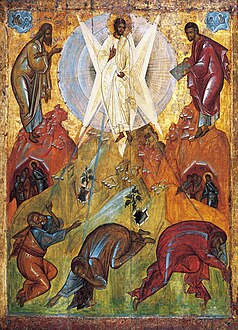
Back تصوف مسيحي Arabic Xristian mistisizmi Azerbaijani Misticisme cristià Catalan Křesťanská mystika Czech Kristen mystik Danish Christliche Mystik German Χριστιανικός μυστικισμός Greek Teología mística cristiana Spanish Kristillinen mystiikka Finnish Mysticisme chrétien French

| Part of a series on |
| Christian mysticism |
|---|
 |
| Part of a series on |
| Palamism |
|---|
 |
|
|
| Part of a series on |
| Christianity |
|---|
 |
Christian mysticism is the tradition of mystical practices and mystical theology within Christianity which "concerns the preparation [of the person] for, the consciousness of, and the effect of [...] a direct and transformative presence of God"[1] or divine love.[2] Until the sixth century the practice of what is now called mysticism was referred to by the term contemplatio, c.q. theoria, from contemplatio (Latin; Greek θεωρία, theoria),[3] "looking at", "gazing at", "being aware of" God or the divine.[4][5][6] Christianity took up the use of both the Greek (theoria) and Latin (contemplatio, contemplation) terminology to describe various forms of prayer and the process of coming to know God.
Contemplative practices range from simple prayerful meditation of holy scripture (i.e. Lectio Divina) to contemplation on the presence of God, resulting in theosis (spiritual union with God) and ecstatic visions of the soul's mystical union with God. Three stages are discerned in contemplative practice, namely catharsis (purification),[7][8] contemplation proper, and the vision of God.
Contemplative practices have a prominent place in Eastern Orthodoxy and Oriental Orthodoxy, and have gained a renewed interest in Western Christianity.
- ^ McGinn 2006.
- ^ Anon. 1857.
- ^ Andrew Louth, "Theology of the Philokalia" in Abba: The Tradition of Orthodoxy in the West (St Vladimir's Seminary Press 2003 ISBN 0-88141-248-1), p. 358
- ^ William Johnson, The Inner Eye of Love: Mysticism and Religion (HarperCollins 1997 ISBN 0-8232-1777-9), p. 24
- ^ Liddell and Scott: θεωρία
- ^ Lewis and Short: contemplatio
- ^ Egan, Harvey D. (September 16, 1998). Christian Mysticism: The Future of a Tradition. Wipf and Stock Publishers. ISBN 9781579101534 – via Google Books.
- ^ Watts, Joel L. (March 10, 2014). Praying in God's Theater: Meditations on the Book of Revelation. Wipf and Stock Publishers. ISBN 9781625641939 – via Google Books.